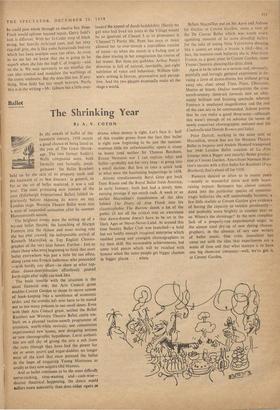Ballet
The Shrinking Year
By A. V. COTON IN the annals of ballet of the twentieth century, 1958 stands a good chance of being listed as the year of The Great Shrink- ./ age. The two former Sadler's Wells companies were, both formally and factually, amal- gamated : the Ballet Rambert held on by the skin of its property teeth and the footwork of its best dancers : in general, so far as the art of ballet mattered, it was a sad year. The most promising new venture of the year (Edinburgh International Ballet) folded in- gloriously before exposing its wares on any London stage. Western Theatre Ballet went into a state of suspended animation after its summer Hammersmith season.
The brightest events were the setting up of a try-out ballet theatre; the launching of Margot Fonteyn into the richest and most testing role she has ever created; the indisputable arrival of Kenneth Macmillan as Top English Choreo- grapher of the very near future. Further : Just to cheer those who were beginning to think that most ballet everywhere was just a little bit too effete, along came two French ballerinas who proceeded —with hardly any effort—to show us what top- class dance-interpretation effortlessly poured forth night after night can look like.
The basic trouble with the situation is the usual financial one; the Arts Council grant enables Covent Garden to shape its secret system of book-keeping into a semblance of economic order, and the crumbs left over have to be meted out to too many patients in too small doses. Even with their Arts Council grant, neither the Ballet Rambert nor Western Theatre Ballet could em- bark on a planned twelve-month programme of creations, worth-while revivals; nor commission experimental new 'scores, new designing notions or new choreographic hypotheses. Local authori- ties are still shy of giving the arts a sub from the rates (though they have had the power for six or seven years) and sugar-daddies no longer exist of the kind that once pursued the ballet in the hope of acquiring Young Mistresses as avidly as they now acquire Old Masters.
And as ballet continues to be the most difficult, nerve-racking, time-wasting and—cash-wise- dearest theatrical happening, the dance world suffers more noticeably than does either opera or drama when money is tight. Let's face it : half of this trouble grows from the fact that ballet is right now beginning to be just the teeniest- weeniest little bit unfashionable; opera is about to boom (and neither Sir Thomas Beecham, Ernest Newman nor I can explain why) and ballet—probably not for very long—is going into a small decline. But first to take a quick look at what were the heartening happenings in 1958.
Almost simultaneously Beryl Grey got back from Russia and the Royal Ballet from America, in early January; both had had a lovely time, earning prestige if not much cash. A week or so earlier Macmillan's transference of the idea behind The Diary of Ann Frank into his claustrophobic The Burrow shook a lot of the public (if not all the critics) into an awareness that dance-drama doesn't have to be set in the Dark Ages or Never-Never-Land. At around this time Sunday Ballet Club was launched—a bold but not boldly enough imagined enterprise which enabled young and youngish choreographers to try their skill. No memorable achievements, but some trial pieces which will be recalled with honour when the same people get bigger chances in bigger places . . . when. Before Macmillan put on his Agon and Ashton his Online at Covent Garden. came a visit of the De Cuevas Ballet which was worth every agonising moment of its more dreadful ballets for the sake of seeing Nina Vyroubova dancing like a queen, an angel, a breeze, a bird—like, in fact, the topmost-rank ballerina she is. Also from France, as a guest artist to Covent Garden, came Yvette Chauvire, dancing like ditto, ditto.
Agon is to be taken as a serious and, obviously, painfully and lovingly gestated experiment in de- vising a form of dance-drama but without giving away any clues about Time, Place, Character, Motive or Intent. Ondine manipulates the nine- teenth-century three-act formula into an alter- nately brilliant and bruising spectacle, wherein Fonteyn is unalloyed magnificence and the rest of the cast are to be commended. Ashton proves that he can make a good three-acter—although this wasn't enough of an advance (in terms of newly conceived choreographic notions) over his Cinderella and Danish Romeo and Juliet.
Peter Darrell, working in the same vein as Macmillan, struck fine ore for Western Theatre Ballet in Impasse and Andree Howard transposed her 1940 London Ballet creation of La Fete Etrange into a Bigger and (nearly) Better produc- tion at Covent Garden. Apart from Norman Mor- rice's success with a first ballet for Rambert (Two Brothers), that's about all for 1958.- Fonteyn danced as often as in recent years —mostly in wonderful form and with heart- raising impact; Beriosova has almost consoli- dated into the particular species of romantic- tragic ballerina she will undoubtedly become; a few little starlets at Covent Garden give evidence of having the capacity to twinkle persistently— and probably more brightly in another year or so. Where's the shrinkage? In the now complete lack of a properly-run experimental stage; in the almost total dry-up of new daring choreo- graphers; in the absence of any new writers of ballet music. One critic (nameless) has come out with the idea that experiments are a waste of time and that what matters is to have one big showcase company—well, we've got it, at Covent Garden.


























 Previous page
Previous page